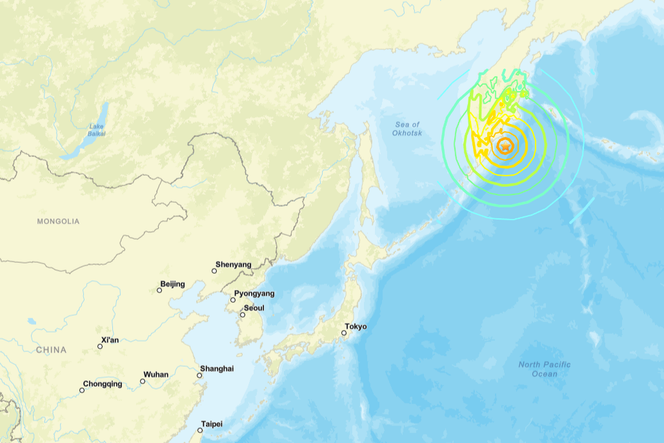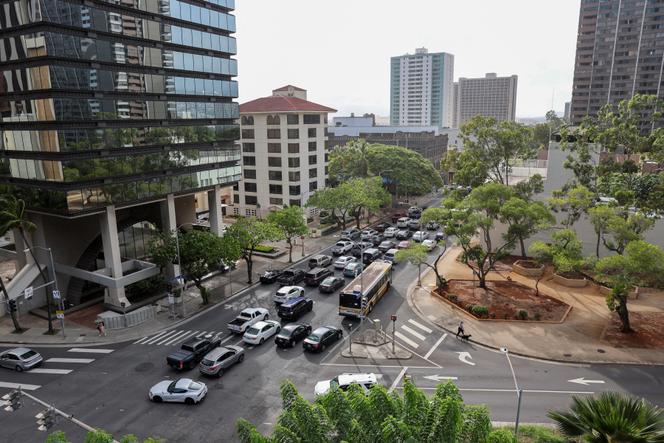8.8-magnitude earthquake off eastern Russia: tsunamis in Russia and Japan, alerts across the Pacific
A magnitude 8.8 earthquake, the most powerful in the region in nearly 73 years, struck late Tuesday, July 29, off Russia's Kamchatka Peninsula, triggering tsunamis in Russia and Japan and prompting alerts across much of the Pacific.
A tsunami in the Pacific Ocean caused flooding in Severo-Kurilsk, in the northern part of Russia's Kuril Islands, the Russian Emergency Situations Ministry announced. Videos posted on social media showed flooded buildings in the town of about 2,000 people, whose residents were evacuated.
Meanwhile, live images on Japanese television showed people evacuating by car or on foot to higher ground, including on the northern island of Hokkaido, where the first tsunami of 30 centimeters was observed.
The US Geological Survey (USGS) initially reported an earthquake with a magnitude of 8.7, before raising its strength to 8.8. It occurred around 23:25 GMT on Tuesday (1:25 a.m. in Paris) at a depth of 20.7 km, about 126 km from the capital of the Kamchatka region in Russia's Far East.
This magnitude is the strongest recorded since 1952 in the Kamchatka region, according to local seismological services.

Japanese television station NHK broadcast special coverage with a news anchor urging coastal residents to evacuate: "Evacuate immediately to save your lives." Employees at the Fukushima nuclear power plant in northern Japan, destroyed by a powerful earthquake and tsunami in March 2011 , were evacuated, its operator said.
"Tsunamis will strike repeatedly. Do not venture out to sea or approach the coast until the warning is lifted," warned the Japan Meteorological Agency (JMA). The agency initially predicted a tsunami of up to 1 meter, but this forecast was later raised to 3 meters.
Some railway lines have been suspended. "Residents in areas where alerts have been issued should immediately evacuate to safe locations, such as higher ground or evacuation buildings," government spokesman Yoshimasa Hayashi urged.
The Japanese alert covers the entire northern and eastern coast of the archipelago, as far south as Osaka, as well as the smaller outlying islands. Beyond that, as well as in Tokyo and Osaka Bays, the tsunami could reach 1 meter.
The US National Tsunami Center (PTWC), describing the potential impact as "dangerous" , warned of a risk of waves of more than 3 meters along certain coasts of Ecuador, the northwest of the Hawaiian Islands and Russia. Ecuadorian authorities have therefore ordered a "preventive evacuation" of the coastline of the Galapagos Islands.
Tsunamis of one to three meters above tide level are also possible along some coasts of Chile, Costa Rica, French Polynesia, Guam, Hawaii, Japan, and other Pacific islands and archipelagos, he added. Tsunamis of up to 1 meter can also be expected elsewhere, including Australia, Colombia, Mexico, New Zealand, Tonga, and Taiwan.
In Mexico, authorities ordered residents along the entire Pacific coast, from Baja California to Chiapas, to stay away from the ocean. The Philippines also urged residents on the east coast to move inland, predicting a tsunami of up to 1 meter, and advised fishermen already at sea to stay offshore in deep waters. China and the Peruvian navy also issued tsunami warnings.
The United States has issued a series of warnings of varying levels along the North American west coast from Alaska to the entire Californian coast. Tsunami warnings have been broadcast to cell phones in some areas of California, according to Agence France-Presse journalists.

At least six aftershocks struck the region, including one of magnitude 6.9 and another of magnitude 6.3, according to the USGS. The Kamchatka Seismological Service warned that aftershocks of up to magnitude 7.5 are expected in the coming days.
On July 20, a magnitude 7.4 earthquake, followed by numerous aftershocks, also occurred off the coast of Kamchatka, without causing major damage.
The epicenter of Tuesday's quake was roughly the same as that of a massive 9.0-magnitude quake in November 1952, which triggered a devastating tsunami across the Pacific, the USGS said.
The Kamchatka Peninsula is the meeting point of the Pacific and North American tectonic plates, making the region one of the most seismically active areas on the planet. Since 1900, seven major earthquakes, with a magnitude of 8.3 or greater, have occurred along the peninsula.
The World with AFP
Contribute
Reuse this content




